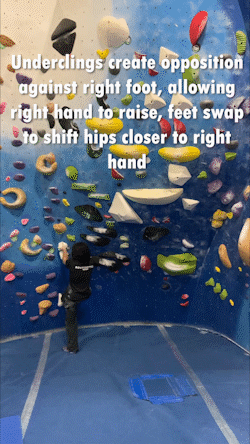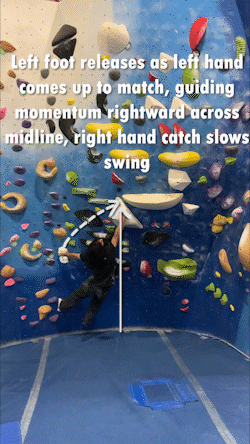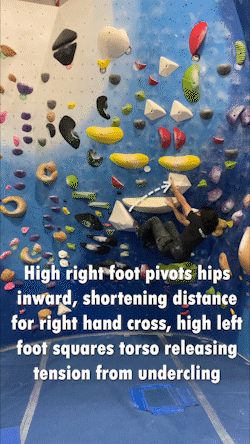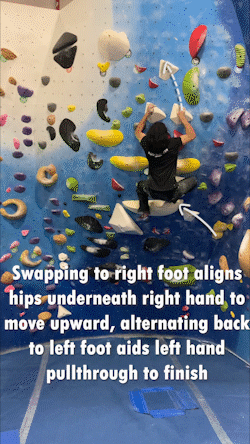Breakdown
Climber: Sid Pinto 5’9”/+1
Wall angle: 10° Overhang > Flat
Holds: Trango Holds Stealth Series, Rock Candy Sledge Colossal, Flathold Damage Control
RIC: Risk 4, Intensity 4, Complexity 1
This boulder was designed with dynamic movement and sloper strength in mind. Risky movements are recurring throughout the climb. The first paddle requires accuracy and multiple actions to complete one movement, while the jump to the finish necessitates commitment and proper distance gauging. Intensity is present through the strength needed to control the dynamic movements and the high body tension utilized to navigate the slopers. If the climber underutilizes their core or shoulder engagement they will likely fall. Complexity is low on this boulder because there are few sequence nuances.
Influence/Aesthetic:
The structure of this boulder was derived from a popular paddle movement that has been doing rounds on social media recently. This involves the climber grabbing and controlling a hold with one hand; this is followed by the climber bringing their second hand to the hold but being unable to control it statically. This requires them to use their momentum to launch their body weight to a second, more positive hold. There are slight elements of aesthetics throughout the boulder, like most of the holds being dual tex and from the same set. However, visuals were not a primary focus in this case.
Hold Selection:
Slopers are the defining factor for movement on this climb. The hold used for the paddle movement must be positive enough to carry momentum through, but not so positive that the climber is able to stop their velocity completely. The Trango Stealth slopers work well for this because they have flat edges, preventing the climber from gaining a closed hand grip. Utilizing them throughout the boulder encourages slow, calculated movement and body positioning. Moving too hastily can shift weight improperly and significantly reduce potential grip strength.
Set It Up
Sid begins by placing his right foot on to create opposition for his hands against the underclings. This allows him to reach his right hand up to grab the next sloper.
He swaps his right foot for a left foot and dangles his right leg closer to his right hand. This brings his hips closer to his right hand, reducing the distance his lower body will have to travel once he jumps.
Let It Fly
Sid brings his left hand up to match. However, this creates too far of a distance from his left foot, forcing him to release it.
The momentum from his lower body brings Sid across the midline created by his hands.
Grabbing the screw on the next hold stops Sid’s momentum and lets him readjust for the next sequence.
Slow and Sloping
Sid brings his right foot high to traction the undercling. The slightly inward position of his foot allows him to drop his right hip close to the wall, closing the distance between the next right-hand hold.
After gaining the right-hand sloper he is able to bring his left foot up and center his torso. His shoulders are able to engage from this squared position and he can release weight from the undercling to move his left hand upward.
Last Launch
Sid swaps to a right foot to align his hips beneath his right hand. This lets him drive through his right foot to reach the next right hand.
He now alternates back to a left foot, using his left leg to generate dynamic force as his left-hand pulls through to the finish.
Final Thoughts
Recreating boulders seen on Instagram or through other video mediums can be difficult for a number of reasons. The top ones being wall angles and hold selection. It can be impossible to tell the angle of the wall from a video. Additionally, it is highly possible that your gym does not have the same wall breaks or angles as the gym shown in the video. Combining these constraints with differing hold selections can make creating replicas difficult. Starting from a frame of reinterpretation can make it easier to utilize the unique features of your gym to set comparable versions of boulders. This helps to bring routesetter’s unique flavors and styles into play, which can expand on these popular movements.




